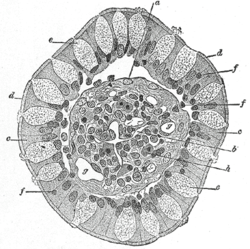Simple columnar epithelium
- Simple columnar epithelium
-
| Simple columnar epithelium |
 |
| Vertical section of a villus from the dog’s small intestine. X 80. (Simple columnar epithelium labeled at right, third from top.) |
 |
Transverse section of a villus, from the human intestine. X 350.
a. Basement membrane, here somewhat shrunken away from the epithelium.
b. Lacteal.
c. Columnar epithelium.
d. Its striated border.
e. Goblet cells.
f. Leucocytes in epithelium.
f’. Leucocytes below epithelium.
g. Bloodvessels.
h. Muscle cells cut across. |
| Code |
TH H2.00.02.0.02020 |
A simple columnar epithelium is a columnar epithelium that is uni-layered. In humans, a simple columnar epithelium lines most organs of the digestive tract including the stomach, small intestine, and large intestine. Simple ciliated columnar epithelia line the uterus. Simple columnar epithelia are further divided into two categories: non-ciliated and ciliated.
Ciliated
Ciliated columnar epithelia move mucus and other substances via cilia, and are found in the upper respiratory tract, the Fallopian tubes, the uterus, and the central part of the spinal cord.
A ciliated columnar epithelium lines the lumen of the uterine tube, where currents generated by the cilia propel the egg cell toward the uterus.
Additional images
-
-
-
-
Vertical section of mucous membrane of human uterus.
-
-
References
External links
|
|
Components
|
|
|
|
see also Template:Epithelial neoplasms
|
Categories:
- Anatomy stubs
- Epithelial cells
Wikimedia Foundation.
2010.
Look at other dictionaries:
Pseudostratified columnar epithelium — Transverse section of tracheal tissue. Note that image is incorrectly labeled ciliated stratified epithelium at upper right. Code TH … Wikipedia
Columnar epithelial cell — Code TH H2.00.02.0.01012 Columnar epithelia are epithelial cells whose heights are at least four times their width. Columnar epithelia are divided into simple (or unilayered), and stratified (or multi layered). Simple columnar epithelia… … Wikipedia
Epithelium — The outside layer of cells that covers all the free, open surfaces of the body including the skin, and mucous membranes that communicate with the outside of the body. By contrast the endothelium is the layer of cells lining the closed internal… … Medical dictionary
Columnar — In biology, columnar refers to the shape of epithelial cells that are taller than they are wide.[1] Form follows function in biology, and columnar morphorphology hints at the functions of the cell. Columnar cells are important in absorption and… … Wikipedia
Epithelium — This article is about the epithelium as it relates to animal anatomy. For the fungal structure of the same name, see Pileipellis. Epithelium Code TH H2.00.02.0.00001 Epithelium is one of the four basic types of animal tissue, along with… … Wikipedia
epithelium — epithelial, adj. /ep euh thee lee euhm/, n., pl. epitheliums, epithelia / lee euh/. Biol. any animal tissue that covers a surface, or lines a cavity or the like, and that, in addition, performs any of various secretory, transporting, or… … Universalium
Olfactory epithelium — Section of the olfactory mucous membrane. Plan of olfactory neurons … Wikipedia
Corneal epithelium — Vertical section of human cornea from near the margin. (Waldeyer.) Magnified. 1. Epithelium. 2. Anterior elastic lamina. 3. substantia propria. 4. Posterior elastic lamina. 5. Endothelium of the anterior chamber. a. Oblique fibers … Wikipedia
epithelium — n. the tissue that covers the external surface of the body and lines hollow structures (except blood and lymphatic vessels). It is derived from embryonic ectoderm and endoderm. Epithelial cells may be flat and scalelike (squamous), cuboidal, or… … The new mediacal dictionary
simple epithelium — An epithelial layer composed of a single layer of cells all of which are in contact with the basal lamina (see basement membrane). May be cuboidal, columnar, squamous or pseudostratified; though the last of these appears superficially to be… … Dictionary of molecular biology







